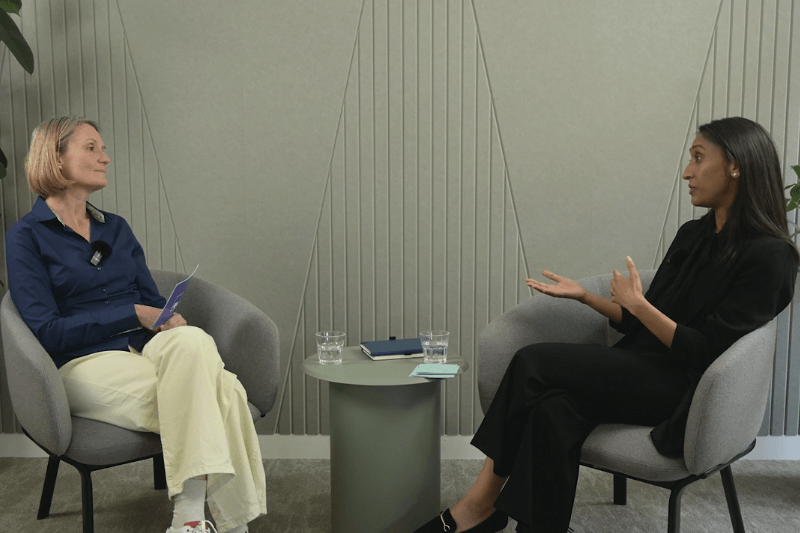*Private healthcare schemes do not cover HRT as a treatment option, but please refer to your membership handbook for more information about other support available.
Hormone Replacement Therapy (HRT) is widely spoken about when it comes to the treatments on offer for those experiencing the perimenopause and the menopause. 7.80 million medications for HRT were prescribed in 2021/22, a 35.0% increase from 2020/21.1
Sally Sullivan, pharmacist in AXA Health’s 24/7 health support line for members, helps explore exactly what HRT is, answers some commonly asked questions and highlights the alternatives available for those who don’t or can’t take it, due to personal choice or health reasons.
What is HRT?
During the menopause, your body starts to make lower levels of hormones, particularly oestrogen. This reduction in oestrogen can cause multiple symptoms in people experiencing menopause, some of the most common include:
- hot flushes,
- difficulty sleeping,
- loss of concentration and memory changes,
- night sweats,
- brain fog,
- and mood changes, including low mood and anxiety.
You can find a more comprehensive list of menopause symptoms, together with a whole host of self-help tips you can try in our article, Our guide to the menopause: symptoms, self help and treatment.
HRT provides oestrogen to replace the lack of natural oestrogen produced by the body and can help alleviate some of the symptoms of the menopause; for some it can be very effective. It’s also not uncommon for the dose and type of HRT to need tailoring. A woman could experience two to three changes of HRT before finding what works best for them.
If you would like to try some HRT to help manage your symptoms, it’s important to speak to your doctor and they will be able to talk about your options, check your medical history and discuss this with you.
Is HRT for everyone?
There are instances where HRT is not suitable, however, with the types of HRT now available, including body identical, and the route it can be administered (through the skin), HRT is generally considered a safe option with the benefits outweighing any potential risks when given at the lowest dose needed for symptom relief, for up to five years in most women.
Clinical reasons like past medical history of some cancers, could mean HRT is not suitable for some people. In these cases, however, there are alternative medications that are non-HRT based that can be given.
It doesn’t mean for anyone who has been told they are not suitable for HRT there are no options, just that therapy in the form of hormone replacement might not be appropriate. If your doctor has indicated HRT may not be suitable, you can always ask for a referral to a menopause clinic and ask for a second opinion from a specialist.
Types of reasons where HRT may not be considered appropriate include:
- Have a history of breast, ovarian or womb cancer – in the case of breast cancer, this will depend on the type and cells involved. Some forms of HRT can still be given but it will be on an individual basis and discussed with a doctor or specialist.
- Have untreated high blood pressure – however, for anyone who’s blood pressure is controlled with medication they are now considered safe to be given HRT, with the newer types now available.
- Have liver disease.
- Have a history of blood clots – however, this is also looked at on an individual basis.
Once your doctor has agreed to prescribe some HRT, they will usually start you on a low to moderate dose, depending on your symptoms and past medical history. It can take a while to get your dose right, as mentioned earlier, and it’s worth bearing in mind that it takes up to three months for the level of HRT in the blood to have built to a steady level – however many women begin to feel relief before this.
Is it necessary to take both oestrogen and progesterone HRT?
The type of HRT prescribed depends on your needs, medical risks and convenience.
For example, women with a uterus will need to take oestrogen and progesterone. Without progesterone, the womb lining can become abnormally thick which could potentially lead to cancer.
If you no longer have a uterus, for example if you have had a hysterectomy, you can have oestrogen-only HRT, unless you suffer from endometriosis, in which case you might need extra progesterone.
If you need oestrogen and progesterone, you will usually need oestrogen every day plus progesterone for the last 12 to 14 days of your 28-day cycle. Or, you could use a combined oestrogen and progestogen medicine every day, depending on whether you are in perimenopause or menopause – but this would be discussed with you by your doctor or specialist.
>Read more: What is the perimenopause?
If you use oestrogen HRT patches, you may need to take additional progesterone tablets, although some patches combine both.
Does taking HRT mean I can’t get pregnant?
HRT doesn’t provide contraception. If you’re under 50 years old, you could be fertile for two years after your last period. If you’re over 50 you could be fertile for up to a year after your last period.2
Using oral contraceptives if you’re older than 50 needs to be based on your individual medical history and potential health risks. You will need to discuss this with your doctor.
Your doctor may be able to perform some blood tests to check if you are fertile.
Side effects of HRT
As with all medicines, there can be side effects when you take HRT and you should read the patient information leaflet that accompanies your medicine, as this will have plenty of information for you.
Typically, someone would have a three-monthly review with their prescriber after beginning HRT to check how things are going.
Common side effects from taking HRT include:
- sensitive breasts or swelling,
- headaches or migraines,
- leg cramps,
- back pain,
- tummy issues – including nausea, bloating, indigestion and pain,
- depression or mood swings,
- or vaginal bleeding.
If you are concerned about any of the side-effects, please do speak with your doctor. Your local pharmacist may also be able to provide some information.
Risk of breast cancer
Short-term use of oestrogen-alone HRT regimens (up to five years) are unlikely to increase the risk of invasive breast cancer.
Combined oestrogen and progesterone can be associated with a small increase in the risk of invasive breast cancer. However, this risk is low in both medical and statistical terms and should be taken in the context of the overall benefits obtained from using HRT.3
Risk of endometrial (or womb) cancer
Oestrogen-only HRT can increase your risk of endometrial cancer which is why it’s only prescribed for women who don’t have a womb.
Your risk very much depends on your dose and how long you have been taking HRT.
Choice of HRT will differ depending on whether someone still has their womb or not. Oestrogen-only HRT is only offered to those without a womb. People who still have their womb will be prescribed a progesterone component, as well as oestrogen to protect it.
Risk of blood clots
Women who take HRT in tablet form are thought to have a small increased risk of developing blood clots. However, when applied to the skin in the form of gels, patches or creams there does not appear to be an increased risk.
This risk is usually low, and your doctor will carefully take any past medical history into account before prescribing any HRT products. It doesn’t mean that no HRT can be given at all if there’s a history of blood clots. Every woman will be looked at on an individual basis.
Trauma, or long periods of immobility, such as prolonged bed rest or a hospital stay, can increase your risk of developing blood clots. If you are having major surgery your doctor may ask you to stop the HRT four to six weeks before surgery.
Risk of heart disease
There is very little data on the risk of heart disease in women who start taking HRT soon after the menopause. Only those who start taking combined HRT, ten years post menopause, are at a slightly greater risk of coronary heart disease.
Consult with your GP if you are thinking about re-starting HRT to consider the risks.
How to stop taking HRT safely
There’s no limit about how long you can take HRT for, so it is important to discuss stopping the medication with your doctor. Many women stop taking HRT after about five years or when their symptoms are no longer a problem.
You can stop HRT immediately, but it is recommended that you gradually reduce your dose over two or three months, especially if you are on a higher dose of oestrogen, to prevent the menopausal symptoms returning.
If you’re taking a low dose of oestrogen the gradual reduction may not be required. On stopping, many women have a return of their menopausal symptoms but these are often mild and resolve in time with no treatment.
If your symptoms are severe when you stop then you need to discuss this matter with your GP who may prescribe a low dose HRT. Your doctor will need to consider your individual risk.
After stopping many women experience bladder and vaginal symptoms. These can be controlled with creams or pessaries that contain a very low dose oestrogen. These still pose the risks associated with the use of HRT but to a lower extent because very little oestrogen is absorbed into your bloodstream.
Alternatives to HRT
If you decide against taking HRT or can’t due to a medical reason, then there are other ways to manage symptoms of the menopause. These include:
- ensuring you exercise regularly,
- maintain a healthy diet, including cutting down on spicy food and alcohol,
- try antidepressants – certain types can help you with hot flushes and night sweats, although they haven’t had clinical trials for this use.
Bio-identical HRT
In recent years, practitioners in some areas have begun to prescribe bio-identical hormones for relief of menopausal symptoms. These are man-made hormones, usually of plant origin and designed to be identical to those produced naturally by the body.
They are available as creams, lozenges, gels and vaginal preparations. They frequently contain a mix of several differing types of oestrogen, progesterone and other sex hormones produced by the body, however there are currently no long-term studies that have been performed on these preparations to look at efficacy and risk.
They are not regulated by the Medicines and Healthcare Products Regulatory Agency (MHRA) and are marketed as natural products. This means they haven’t been through the rigorous process of drug development, which conventional medicines and products usually undergo and therefore haven’t been scientifically evaluated in clinical trials for effectiveness and safety.
Complementary and alternative therapies
Choosing a complementary or alternative therapy is also available:
- Acupuncture
- Aromatherapy
- Herbal treatments
- Homeopathy
- Hypnotherapy
- Yoga
- Reflexology
These have all been reported as being helpful during menopause. As well as the use of vaginal lubricants which can help to overcome vaginal dryness and soreness in some women.
Plant extracts such as St John’s wort may help reduce night sweats and red clover can be used to help alleviate symptoms associated with the decline in oestrogen production4. It’s however worth highlighting, that research studies have shown red clover needs to be taken up to 6 months before any main relief is felt.
Cognitive behavioural therapy (CBT) is also another potential option, as it can help some of the symptoms such as low moods or anxiety caused by the menopause; as well as insomnia and some physical symptoms such as joint pain.5
Menopausal women may feel overwhelmed with the symptoms they can experience leading up to and during the menopause and feel unsure on what treatment option is for them. Try keeping a symptom diary and make a note each day of how you’re feeling, scoring any symptoms according to how bad you’re finding them. This can help form the basis of a chat with your GP, or menopause specialist, and they can help look at ways these can be managed and treated.
Remember, friends and family can help support too or just be there to listen when you need them.
>Read more: How can you help support someone through the menopause?
References
- Hormone Replacement Therapy – England – April 2015 to June 2022 - NHS
- About hormone replacement therapy (HRT) – NHS UK
- HRT Guide - British Menopause Society
- Herbal remedies and complementary medicines for menopause symptoms - NHS
- Treatment - NHS














